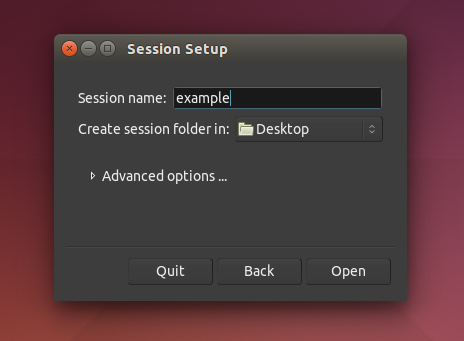“Ardour4 初学者教程 02 开始入门”的版本间的差异
来自Ubuntu中文
(→启动Ardour) |
|||
| 第3行: | 第3行: | ||
=启动Ardour= | =启动Ardour= | ||
[http://brunoruviaro.github.io/ardour4-tutorial/starting-ardour-on-ubuntu/ (原文)] | [http://brunoruviaro.github.io/ardour4-tutorial/starting-ardour-on-ubuntu/ (原文)] | ||
| + | |||
| + | =启动Ardour= | ||
| + | [http://brunoruviaro.github.io/ardour4-tutorial/starting-ardour-on-ubuntu/ (原文)] | ||
| + | |||
| + | Simply click on the Ardour icon to start the program. | ||
| + | |||
| + | On Ubuntu, you can find and launch software using the Dash. Tap the “Super” key (or “Super” + “A” to go directly to the Dash App Lens) and type Ardour. You can then click on the Ardour icon, or simply hit Enter when Ardour is the first search result: | ||
| + | |||
| + | http://brunoruviaro.github.io/ardour4-tutorial/images/Ardour4_Ubuntu_Dash.png | ||
| + | |||
| + | Click on Ardour-4 and the program will start. | ||
| + | |||
| + | Once you have started Ardour, the Session Setup window shows up. | ||
| + | |||
| + | http://brunoruviaro.github.io/ardour4-tutorial/images/Ardour4_Session_Setup.png | ||
| + | |||
| + | You can click on New Session to create a brand new session, or you can open an existing session using the Other Sessions options. For now let’s create a fresh session, so click on New Session. The window should now look like the screenshot below. | ||
| + | |||
| + | Name your new project and click Open . | ||
| + | |||
| + | http://brunoruviaro.github.io/ardour4-tutorial/images/Ardour4_Session_Setup_2.png | ||
| + | |||
| + | TIP: Avoid using any characters other than letters and numbers when naming your session. Avoid white spaces, accented letters, !@#$%*()+, periods, commas, etc. Use dashes or underscores if you like. For example, instead of “My Great Session!”, prefer “My_Great_Session”, or “MyGreatSession”, or “my-great-session”. Instead of “Açaí”, write “Acai” (without accented letters), etc. Once you have created your Ardour session, do not manually rename any folders or files that belong to the Session. | ||
| + | |||
=界面概览= | =界面概览= | ||
[http://brunoruviaro.github.io/ardour4-tutorial/an-overview-of-the-interface/ (原文)] | [http://brunoruviaro.github.io/ardour4-tutorial/an-overview-of-the-interface/ (原文)] | ||
2015年10月24日 (六) 20:41的版本
目录
启用JACK
启动Ardour
启动Ardour
Simply click on the Ardour icon to start the program.
On Ubuntu, you can find and launch software using the Dash. Tap the “Super” key (or “Super” + “A” to go directly to the Dash App Lens) and type Ardour. You can then click on the Ardour icon, or simply hit Enter when Ardour is the first search result:

Click on Ardour-4 and the program will start.
Once you have started Ardour, the Session Setup window shows up.

You can click on New Session to create a brand new session, or you can open an existing session using the Other Sessions options. For now let’s create a fresh session, so click on New Session. The window should now look like the screenshot below.
Name your new project and click Open .

TIP: Avoid using any characters other than letters and numbers when naming your session. Avoid white spaces, accented letters, !@#$%*()+, periods, commas, etc. Use dashes or underscores if you like. For example, instead of “My Great Session!”, prefer “My_Great_Session”, or “MyGreatSession”, or “my-great-session”. Instead of “Açaí”, write “Acai” (without accented letters), etc. Once you have created your Ardour session, do not manually rename any folders or files that belong to the Session.